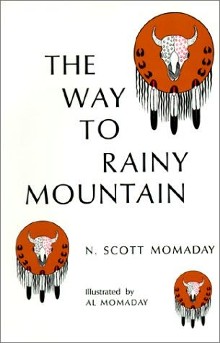
Kiowa County is a county located in the southwestern part of the U.S. state of Oklahoma. As of the 2020 census, the population was 8,509. Its county seat is Hobart. The county was created in 1901 as part of Oklahoma Territory. It was named for the Kiowa people.
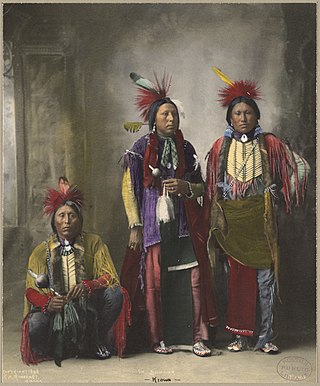
Kiowa or CáuigúIPA:[kɔ́j-gʷú]) people are a Native American tribe and an indigenous people of the Great Plains of the United States. They migrated southward from western Montana into the Rocky Mountains in Colorado in the 17th and 18th centuries, and eventually into the Southern Plains by the early 19th century. In 1867, the Kiowa were moved to a reservation in southwestern Oklahoma.

Gerald Robert Vizenor is an American writer and scholar, and an enrolled member of the Minnesota Chippewa Tribe, White Earth Reservation. Vizenor also taught for many years at the University of California, Berkeley, where he was Director of Native American Studies. With more than 30 books published, Vizenor is Professor Emeritus at the University of California, Berkeley, and Professor of American Studies at the University of New Mexico.
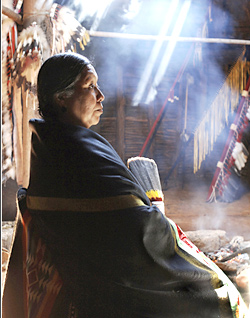
The Plains Apache are a small Southern Athabaskan group who live on the Southern Plains of North America, in close association with the linguistically unrelated Kiowa Tribe. Today, they are centered in Southwestern Oklahoma and Northern Texas and are federally recognized as the Apache Tribe of Oklahoma.

House Made of Dawn is a 1968 novel by N. Scott Momaday, widely credited as leading the way for the breakthrough of Native American literature into the mainstream. It was awarded the Pulitzer Prize for Fiction in 1969, and has also been noted for its significance in Native American anthropology.
The Cutthroat Gap massacre occurred in 1833, "The Year the Stars Fell" in Oklahoma. A group of Osage warriors charged into a Kiowa camp and brutally slaughtered the women, children and elderly there. Most of the warriors of this group of Kiowas, headed by Chief A'date or "Islandman" had left to raid a band of Utes or had gone bison hunting. The camp was left mainly unguarded and when the Osage came, the Kiowas had no choice but to flee. The Osage killed approximately 150 Kiowa people and took their sacred Tai-me medicine bundle and two children captive.
Rainy Mountain is a rounded hill standing northwest apart from the main Wichita Mountains in Kiowa County, Oklahoma. It was a prominent landmark for the Plains Indians on the southern plains.
The Native American Renaissance is a term originally coined by critic Kenneth Lincoln in the 1983 book Native American Renaissance to categorise the significant increase in production of literary works by Native Americans in the United States in the late 1960s and onwards. A. Robert Lee and Alan Velie note that the book's title "quickly gained currency as a term to describe the efflorescence on literary works that followed the publication of N. Scott Momaday's House Made of Dawn in 1968". Momaday's novel garnered critical acclaim, including the Pulitzer Prize for Fiction in 1969.

Lone Wolf the Younger, also known as Gui-pah-gho the Younger, or the Elk Creek Lone Wolf was a Kiowa and warrior originally named Mamay-day-te.After a raid he was given the name Gui-pah-gho by Gui-pah-gho the Elder after avenging the death of Tau-ankia, the only son of Gui-pah-gho the Elder. Mamay-day-te participated in a raid avenging deaths and counted his first coup during the attack. Lone Wolf the Younger led the Kiowa resistance to United States governmental influence on the reservation, which culminated in the Supreme Court case Lone Wolf v. Hitchcock.
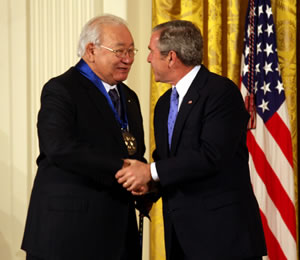
Navarre Scott Momaday was an American and Kiowa novelist, short story writer, essayist, and poet from Oklahoma and New Mexico. His novel House Made of Dawn was awarded the Pulitzer Prize for Fiction in 1969, and is considered the first major work of the Native American Renaissance. His follow-up work The Way to Rainy Mountain blends folklore with memoir. Momaday received the National Medal of Arts in 2007 for his work's celebration and preservation of Indigenous oral and art tradition. He held 20 honorary degrees from colleges and universities, the last of which was from the California Institute of the Arts in 2023, and was a fellow of the American Academy of Arts and Sciences.
Lone Wolf v. Hitchcock, 187 U.S. 553 (1903), was a landmark United States Supreme Court case brought against the US government by the Kiowa chief Lone Wolf, who charged that Native American tribes under the Medicine Lodge Treaty had been defrauded of land by Congressional actions in violation of the treaty.
The Fort Sill Apache Tribe of Oklahoma is the federally recognized Native American tribe of Chiricahua Warm Springs Apache in Oklahoma.
James Auchiah (1906–1974) was a Kiowa painter and one of the Kiowa Six from Oklahoma.
Kenneth Morrison Roemer, an Emeritus Professor at the University of Texas at Arlington, an Emeritus Fellow, UT System Academy of Distinguished Teachers, and a former Piper Professor of 2011, Distinguished Scholar Professor, and Distinguished Teaching Professor at the University of Texas at Arlington. He is the author or editor of four books on utopian literature, including The Obsolete Necessity (1976), nominated for a Pulitzer, and three books on American Indian literatures, including the co-edited Cambridge Companion to Native American Literature (2005). His collection of personal essays about Japan, Michibata de Dietta Nippon (2002) (A Sidewalker’s Japan), was a finalist for the Koizumi Yakumo Cultural Prize. He is the project director of a digital archive of tables of contents of American literature anthologies Covers, Titles, and Tables: The Formations of American Literary Canons.
The Native Writers' Circle of the Americas (NWCA) is an organization of writers who identify as being Native American, First Nations, or of Native American ancestry.
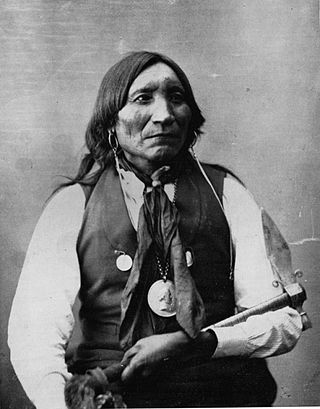
Guipago or Lone Wolf the Elder was the last Principal Chief of the Kiowa tribe. He was a member of the Koitsenko, the Kiowa warrior elite, and was a signer of the Little Arkansas Treaty in 1865.
Native American literature is literature, both oral and written, produced by Native Americans in what is now the United States, from pre-Columbian times through to today. Famous authors include N. Scott Momaday, Leslie Marmon Silko, Simon Ortiz, Louise Erdrich, Gerald Vizenor, Joy Harjo, Sherman Alexie, D'Arcy McNickle, James Welch, Charles Eastman, Mourning Dove, Zitkala-Sa, John Rollin Ridge, Lynn Riggs, Hanay Geiogamah, William Apess, Samson Occom, Gerald Vizenor, Stephen Graham Jones, et al. Importantly, it is not "a" literature, but a set of literatures, since every tribe has its own cultural traditions. Since the 1960s, it has also become a significant field of literary studies, with academic journals, departments, and conferences devoted to the subject.

Ahpeahtone, also known as Que-Tah-Tsay or Apiatan was a chief of the Kiowa tribe in Oklahoma, who is regarded as the last traditional chief of the tribe.
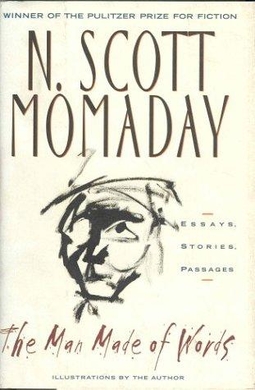
The Man Made of Words: Essays, Stories, Passages, written by N. Scott Momaday and published in 1997, is a collection of stories and essays written over a period of more than 30 years. The selections are grouped into three parts.
